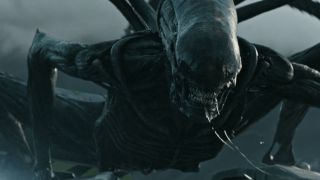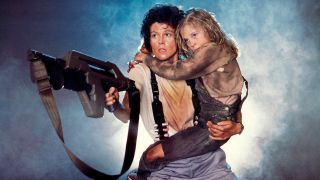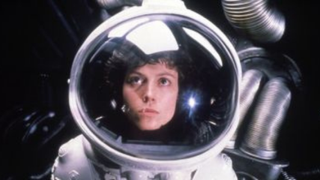Alien Movie Timeline Explained: All Alien Movies In Order, Chronologically And By Release Date
In space, it's easy to choose Chronological or Story Order for the Alien movies.
When a film franchise starts to play with the prospect of prequel films that backfill the universe, it gets a little hard to keep in mind which films go where. The Alien movie timeline is definitely a mixed bag in that respect, as one numbered entry and some suggestive titles help hint at the order in which the films are supposed to be watched in.
If you ask us though, this is one of those instances where hints are for fools, and good, sound facts are needed. How else would you know where the upcoming nightmare factory Alien: Romulus would fit into the picture? So leave it to us here at CinemaBlend to help you sort out how to watch the Alien movies in either chronological or story order!
We’ll be giving you the list of how to watch the films, both in the order they were released, and the order in which their events take place on the overall timeline. As such, it’s important to start with the order that the Alien timeline dictates within its unique universe.
Alien Movies In Chronological Order
Kicking things off, here’s the list of Alien movies, in order of their occurrence on the franchise’s timeline. We’ve noted the years each film covers next to their titles, for easy reference:
Prometheus (2089 – 2093)

The start of the entire Alien timeline, Prometheus shows us the initial journey that took humanity to the stars, and crossing paths with the race of lifeforms known as “The Engineers.” As this entry takes place a little under a century before Alien, we don’t see Sigourney Weaver’s Ellen Ripley, or any of the other space truckers that director Ridley Scott’s first film introduced us to.
However, humanity’s first voyage into deep space yields a more horrifying result than anyone could have anticipated. As far as characters go, we do get two new figures that are integral to the earlier years of the Alien series: Michael Fassbender’s David, an android sent by the Weyland Corporation to aid in the journey, and Noomi Rapace’s Elizabeth Shaw, an archeologist. This intrepid scientist not only helps find the location of The Engineers, but gets to experience the first steps in the creation of the Xenomorphs up close and way too personal.
As David’s arc stands as the narrative glue, with Guy Pearce’s Peter Weyland acting as one of the enigmatic forces behind the Weyland-Yutani Corporation, this is the foundation all other films are to operate upon. Even with several outstanding Prometheus questions waiting to be answered, the facts we do have are crucial to future events. At least, that much is true when it comes to its direct sequel, Alien: Covenant.
CINEMABLEND NEWSLETTER
Your Daily Blend of Entertainment News
Alien: Covenant (2104)

In Alien: Covenant, we’re only 11 years past the point that Prometheus left off on, with a brand new crew of human settlers making their way on a deep space colonization mission. With a supposedly suitable world that could shave years off of their voyage, the crew of the Covenant run into someone who’s had experience with deep space exploration, and the creatures that hide in its shadows.
We see Michael Fassbender pulling double duty in the Alien movie timeline, as a new android named Walter is introduced by the crew of Alien: Covenant’s voyage, and we see the roots of the franchise’s stories pertaining to androids with a hidden agenda. Though there’s also leaps and bounds to be had in terms of the evolution of the Xenomorphs, thanks to the Alien: Covenant prologue revealing how David’s experimentation has helped develop the species.
What's also important is the second, and so far last, appearance of Guy Pearce’s Peter Weyland; via a flashback at the beginning of Covenant. While we haven’t seen the Weyland-Yutani Corporation form just yet, the increasing obsession that Weyland has with observing The Engineers, learning their secrets, and weaponizing their own creations continues to strengthen. Though some of those mysteries may be answered in the future, thanks to what we know about Noah Hawley’s Alien series for FX. With that show set roughly around the same time as Prometheus, perhaps we haven’t seen the last of the Weyland family on our screens.
Alien (2122)

We’re now caught up to the “modern” era of the Alien movie timeline, with Alien’s legendary story finally slotting into the overall series at roughly 18 years after Alien: Covenant’s events. What was once a random mission to obtain a secret cargo on LV-426, Alien’s adventure now connects to a greater mythology that shows a humanity that’s dominated by mega-corporations, with one of them looking to get their hands on this perfect, remorseless killing machine.
Sigourney Weaver’s Ellen Ripley makes her franchise debut in Alien, and takes over as the focused lead of the Alien movie timeline from this point on. And, as of this moment, there are no further links between her lineage and the worlds of either Prometheus or Alien: Covenant. Though there is an eventual adversarial relationship that Ripley will have with androids (in the form of Ian Holm’s Ash in Alien) as well as the Weyland-Yutani Corporation.
Ripley’s aversion to synthetic beings and “The Company” aren’t totally developed here. We see the Xenomorph and Ripley square off for the first time in what will be a battle across time, as both parties find themselves on one hell of a ride from this point on.
Alien: Romulus (2142)

Midquels can be tricky, especially with a series that has a rich history like Alien. However, director Fede Alvarez has promised that Alien: Romulus isn’t “upsetting the canon” by taking place 20 years after Ridley Scott’s iconic origin story. As for what we should expect out of this tale, well, we only know some vague details, in anticipation of the movie’s theatrical release on August 16th.
As far as the story goes, Romulus focuses on a new batch of “young space colonizers” who dock on a space station, and get more than they bargained for. And by that, we mean an army of Facehuggers, eventual full grown Xenomorph terror, and odds of survival so low that we shouldn’t expect too many members of this crew to survive for future installments.
Oh, and don’t expect any potential survivors to all of a sudden meet a CGI de-aged Sigourney Weaver. If this entry is supposed to preserve the existing canon, there’s a very good reason we won’t be seeing Ellen Ripley appearing in Alien: Romulus, unless a specific type of reference or cameo happens to be a part of what we see transpire.
Aliens (2179)

The genesis for what we’ve come to know the Alien timeline to represent comes mostly from writer/director James Cameron’s sequel, Aliens. The story of Ellen Ripley waking up 57 years after the harrowing terror of Alien had concluded, and it’s up to her and a team of space marines to land on LV-426 and investigate a Weyland-Yutani Corporation colony that’s just gone dark.
Ripley’s second big grudge is finally nailed into place, with Weyland-Yutani sending a rather untrustworthy human, courtesy of Paul Reiser’s Carter, instead of the now typical android menace. In a strange reversal, the mission’s android, Bishop, played by Lance Hendrickson, actually turns out to be one of the more heroic synthetics in the history of the Alien movie timeline.
While the newer Alien movies have started to build the backstory to Weyland-Yutani’s formation as “The Company” that poses the greatest human menace in the series, Aliens was where it started. Blending action with a cyberpunk-style corporate overlord in the mix, James Cameron’s hysterical Aliens pitch amounted to something that would take further shape throughout the rest of the franchise.
Alien 3 (2179)

One of the more controversial sequels that occupy the Alien movie timeline, Alien 3 takes place right after the events of Aliens. Sigourney Weaver’s Ripley is now the lone survivor of the events of the second film, with director David Fincher’s entry stranding our hero on a hellish penal colony.
But, seeing as it’s a sequel in the Alien timeline, Alien 3 does see the return of the Xenomorphs, as a random Facehugger has laid its egg in Ripley’s chest. This was supposed to mark the end of the Alien series, as Ripley surely wouldn’t survive tangling with an alien inside of her. Not to mention, her grudge against the Weyland-Yutani Corporation saw what looked like its ultimate resolution.
With Ripley carrying a queen alien embryo inside of her, and Weyland-Yutani wanting to recover this specimen for their ultimately nefarious purposes, her supposed death was the ultimate nail in the coffin. Though as any good writer will tell you, if there’s a will to continue a franchise, there’s a way.
Alien Resurrection (2379)

Jumping 200 years into the future, into the latest point in the Alien timeline, Alien: Resurrection sees Ripley returning in the most unconventional way possible: as a clone. With her DNA on file, and the queen embryo mixed in as part of the state that Ripley was found in in Alien 3, a new queen Xenomorph is also born, as part of the same military experiment.
We now get to see Ripley having somewhat of a psychic, and spiritual, connection with the very creature she’s been known to hate in the Alien timeline. With a crew of smugglers that feel like a first draft of Firefly’s eventual rag tag team, Alien Resurrection sees Ripley team with these fun criminals to survive the day, and destroy the queen in the process.
As far as the adversarial structure of Alien Resurrection goes, the shadowy space military led by Dan Hedaya’s General Martin Perez is the human menace; with their scientific branch bringing Ripley-8 and the Queen Alien hybrid into being through cloning experiments. And while Weyland-Yutani’s thread is officially closed out, there’s still a synthetic friend to be had in Winona Ryder’s Call, a member of the team of bandits inadvertently helping the military with their Xenomorph experiments.
What we’ve gone over so far is what constitutes the current run of Alien timeline history, as all six films are laid out in chronological order above. However, the Alien movie timeline runs a bit differently in our reality, which means it’s time to clarify how the series should run according to human, and box office, history.
Alien Movies Ordered By Release Date

If you’re interested in watching the Alien movies in the order in which they were released, then you’d have to compartmentalize things a little differently. You’re probably asking how much differently things run in the “correct order,” in which case we have the following timeline to lay down.
Here's the order of the Alien movies by release date, for those interested:
- Alien (1979)
- Aliens (1986)
- Alien 3 (1992)
- Alien: Resurrection (1997)
- Prometheus (2012)
- Alien: Covenant (2017)
- Alien: Romulus (2024)
With the course of the original Alien entries running pretty much straightforward in order, the story is pretty easy to follow along with in a linear fashion when it comes to Ellen Ripley’s part of the franchise. However, once you get to Prometheus and Alien: Covenant, it’s obviously going to feel like the Alien movie timeline has taken its cues from the Star Wars universe.
Thankfully, the story’s not so involved that it’s difficult to understand how things match up, no matter which way you decide to enjoy the Alien series. Should you be looking for a recommendation, though, it would be safe to side with the story in chronological order, as they help flesh out events and themes that the franchise ultimately aims to portray throughout its entire run.
And, keep in mind, whether or not we actually get Ridley Scott’s pitched Alien: Covenant sequel, planned to fit somewhere between Alien: Covenant and Alien, the bonds between the modern and classic era of the Alien timeline just might get even stronger. As it currently stands, though, these are the definitive timelines to the Alien movies. So enjoy these movies whichever way you see fit, and be careful the next time you come across a field of giant, pulsating eggs. Though what you'd be doing in that sort of location really does beg to question what you're doing with yourself at that particular moment in life.

Mike Reyes is the Senior Movie Contributor at CinemaBlend, though that title’s more of a guideline really. Passionate about entertainment since grade school, the movies have always held a special place in his life, which explains his current occupation. Mike graduated from Drew University with a Bachelor’s Degree in Political Science, but swore off of running for public office a long time ago. Mike's expertise ranges from James Bond to everything Alita, making for a brilliantly eclectic resume. He fights for the user.
Most Popular





